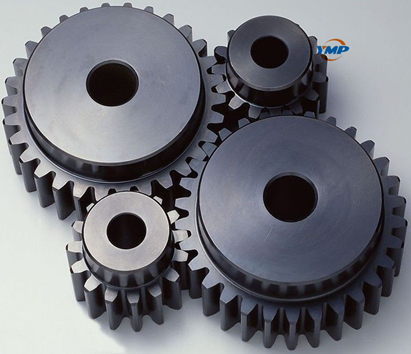Gears with gear accuracy above level 6 and roughness less than Ra0.4μm need to be finished after general rolling and inserting processing. Precision machining methods of gears include shaving, honing, grinding, grinding, etc., which are mainly used for gear tooth profile processing. In addition to the contour finishing of the gear end face and inner hole, finishing is also required. What kind of efficient finishing method should be used for these two parts.
1. Shaving teeth. Gear shaving is a common finishing method used to improve tooth profile accuracy and reduce surface roughness after hobbing or shaping soft gears. The shaving cutter is essentially a helical gear with high precision and high cutting ability. Its meshing with the gear blank machine tool is equivalent to the meshing of the cross-axis helical gear. The relative motion speed between the conjugate tooth surfaces is used to generate cutting motion, forming generated cutting. Cutting processing method for processing cylindrical gears.
In principle, tooth shaving belongs to the generation method. The prop used is called a shaving cutter. Its shape is very similar to a helical cylindrical gear. The tooth shape is very accurate, and many small grooves are opened on the tooth surface to form a cutting edge. During the meshing operation of the processed gear, numerous cutting edges on the tooth surface of the shaving cutter shave filamentous chips from the tooth surface of the workpiece to improve tooth profile accuracy and reduce tooth surface roughness.
Gear shaving is generally performed on a specialized gear shaving machine, or it can also be performed on equipment modified from other machine tools such as milling machines. The accuracy of shaving mainly depends on the accuracy of the shaving cutter, which is about one level higher than before shaving, and can reach level 6-5. Because the shaving cutter has high durability and productivity, and the machine tool is simple and easy to adjust, it is widely used for the finishing of spur and helical cylindrical gears with unhardened tooth surfaces (less than 35hrc). When the tooth surface hardness exceeds 35hrc, shaving cannot be used, and gear honing and grinding are required for finishing.
2. Teeth honing. The principle of gear honing is exactly the same as that of gear shaving, except that a honing wheel is used instead of a shaving cutter. The honing wheel is a helical cylindrical gear that is cast or hot-pressed with abrasives and epoxy resin and has very high tooth profile accuracy. When it drives the workpiece to rotate at a high speed, it can remove a very thin layer of metal on the tooth surface of the workpiece, reducing the tooth surface roughness value to less than Ra0.4μm. Gear honing does not significantly improve the tooth profile accuracy, but mainly reduces the roughness of the tooth surface after heat treatment.Gear honing is performed on a special gear honing machine. The gear honing machine is not much different from the gear shaving machine, but the rotation speed is much higher.
3. Grind teeth. Grinding is one of the finishing methods for gears. Its processing principle is to allow the gear to be ground to mesh freely with a lightly braked grinding wheel, and add abrasives between the meshed tooth surfaces to make use of the relative relationship between the tooth surfaces. slide.
Gear grinding is one of the methods of gear finishing. The processing principle is to make the grinding gear mesh freely with the grinding wheel under slight braking, and add abrasive between the meshing tooth surfaces. By utilizing the relative sliding of the eating surfaces, a thin layer of metal is cut on the tooth surface of the gear to reduce surface roughness and correct local errors of the gear. There are two grinding methods parallel axis grinding and staggered axis grinding.
4. According to the processing principle, gear grinding can be divided into forming method and forming method. It is specially used for finishing gears with hard tooth surfaces. Gear grinding can grind hard tooth surfaces, eliminate heat treatment deformation, and improve product accuracy and tooth surface roughness. A processing technology in which the gear shaping cutter uses the generation method to process gears in addition to gear hobbing. In the teaspoon process, the gear shaping cutter and the workpiece are equivalent to the meshing of a pair of cylindrical gears. The reciprocating motion of the gear shaper cutter is the main motion of the gear shaper cutter, and the circular motion of the gear shaper cutter in a certain proportion with the workpiece is the feed motion of the gear shaper cutter.
